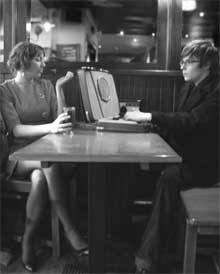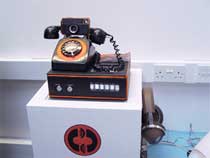 Graham Pullin asked his 3rd year students in Interactive Media Design in Dundee to engage with a history of interaction design that is much longer than that of digital electronics, and reflect on the social as well as technological changes that have taken place. They had to research Lost and Dead Media (cf. miss.gunst's post on the Found Tapes Exhibition and Zoe Irvine's Magnetic Migrating Music project) and build working models (using found objects and MaxMSP on iMacs) of fictitious historical products that might have been lost precursors to modern products and media. To underpin their authenticity, they filmed documentaries with archive film footage, and uncovered contemporary photography and packaging.
Graham Pullin asked his 3rd year students in Interactive Media Design in Dundee to engage with a history of interaction design that is much longer than that of digital electronics, and reflect on the social as well as technological changes that have taken place. They had to research Lost and Dead Media (cf. miss.gunst's post on the Found Tapes Exhibition and Zoe Irvine's Magnetic Migrating Music project) and build working models (using found objects and MaxMSP on iMacs) of fictitious historical products that might have been lost precursors to modern products and media. To underpin their authenticity, they filmed documentaries with archive film footage, and uncovered contemporary photography and packaging.
The result is the fabulous, quirky and poetic Museum of Lost Interactions (MoLI).
Examples (each of the projects deserves a post but i had to choose two of them. Some readers complain that i blog too much):
The Case Communicator, developed in 1936, was a laptop/PDA in a briefcase. This portable electronic workstation allowed male executives to get a 24/7 link to their secretary. Through the connection stream, the businessman is connected to the developers' switchboard where his personal 24 hour secretary is ready to fill his "every need" (news headlines, favourite music and schedule.) A project by Alison Thomson and Shaun McWhinnie.
Conceived at the beginning of the 70s, Pester (the Portable Enhanced System for Telecommunication Entertainment and Recreation) is the first smart phone. It contains a cassette player, camera and games as well as a phone.


Pester relied on a wired network using Connection Points positioned at convenient locations (parks, shopping centres and restaurants as well as regular sites along streets.) These Connection Points allowed callers to access an operator who could let them communicate with landline users, fellow Pester owners and also record and send vocal messages.
Pester contains a player for cassettes that held as much music as an LP! With video games in their infancy, the designers of Pester incorporated a set of playing cards into the back compartment for their recreation. A camera was integrated into the handset as well.
With the development of cellular networks by the 80s, Pester soon lost its appeal. A project by John Drummond and Euan McGhee.

